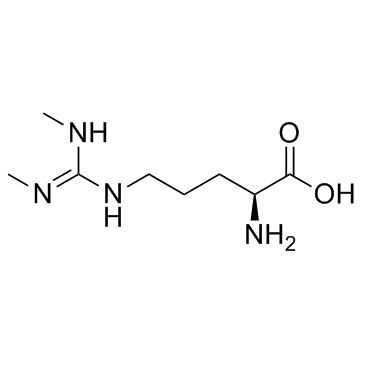| Description |
SDMA (Symmetric dimethylarginine) is an endogenous inhibitor of nitric oxide (NO) synthase activity.
|
| Related Catalog |
|
| Target |
Human Endogenous Metabolite
|
| In Vitro |
SDMA is the structural isomer of the cardiovascular risk marker asymmetric dimethylarginine, as an endogenous marker of renal function. SDMA does not directly inhibit NOS but is a competitor of arginine transport. SDMA is primarily eliminated by renal excretion and is a promising endogenous marker of glomerular filtration rate[1]. SDMA inhibits dose dependently the NO synthesis in intact endothelial cells, whereas it has no effect on protein expression of NOS[1]. SDMA is involved in the inflammatory process of chronic kidney disease, activating NF-κB and resulting in enhanced expression of IL-6 and TNF-α[2].
|
| In Vivo |
SDMA is highly stable in serum and plasma, and the assay demonstrates excellent analytical performance. In unaffected dogs, SDMA remains unchanged whereas in affected dogs, SDMA increases during disease progression, correlating strongly with an increase in sCr and decrease in GFR[3]. Chronic SDMA infusion leads to a significant increase of SDMA levels in mice, but the GFR did not change at 4 weeks. No histological changes are observed, particularly no effect on fibrosis or endothelias nitric oxide synthase expression. There is neither an effect of SDMA on systolic blood pressure nor on ejection fraction[4].
|
| Cell Assay |
SDMA stock solution is prepared in 0.9% NaCl and diluted in the cell culture medium or in heparinized whole blood resulting in a maximal uremic concentration of 6.1 μM SDMA. Whole blood is incubated with saline (control) or different doses of ADMA (0.6, 3.6, and 36 μM) or SDMA (1.5, 3.1, and 6.1 μM) for 2 hours in a humidified atmosphere of 5% CO2 in air at 37°C. Cells are finally stained for intracellular TNF-α or IL-6. Samples are analyzed with a flow cytometer[2].
|
| Animal Admin |
Mice: Eight-week-old male C57Bl/6 mice receives vehicle-controlled infusion of SDMA (250 µmol/kg/days) for 28 days using osmotic minipumps (n=24/group). Glomerular filtration rate, cardiac function and blood pressure are monitored. Blood samples for SDMA determination are obtained at baseline, 2 and 4 weeks. Mice are euthanized at 4 weeks to obtain tissue for renal histology[4].
|
| References |
[1]. Bode-B?ger SM,et al. Symmetrical dimethylarginine: a new combined parameter for renal function and extent ofcoronary artery disease. [2]. Schepers E, et al. Symmetric dimethylarginine as a proinflammatory agent in chronic kidney disease.Clin J Am Soc Nephrol. 2011 Oct;6(10):2374-83. [3]. Nabity MB, et al. Symmetric Dimethylarginine Assay Validation, Stability, and Evaluation as a Marker for the EarlyDetection of Chronic Kidney Disease in Dogs. J Vet Intern Med. 2015 Jul-Aug;29(4):1036-44. [4]. Veldink H, et al. Effects of chronic SDMA infusion on glomerular filtration rate, blood pressure, myocardial function and renal histology in C57BL6/J mice. Nephrol Dial Transplant. 2013 Jun;28(6):1434-9.
|
